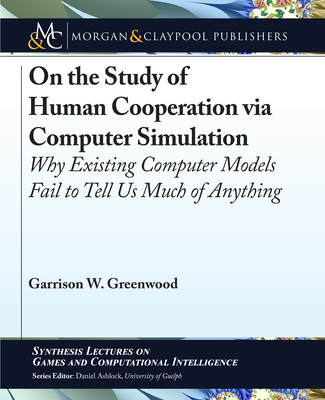On the Study of Human Cooperation via Computer Simulation: Why Existing Computer Models Fail to Tell Us Much of Anything
暫譯: 透過電腦模擬研究人類合作:現有電腦模型為何無法告訴我們太多資訊
Greenwood, Garrison W., Ashlock, Daniel
- 出版商: Morgan & Claypool
- 出版日期: 2019-09-12
- 售價: $1,630
- 貴賓價: 9.5 折 $1,549
- 語言: 英文
- 頁數: 94
- 裝訂: Quality Paper - also called trade paper
- ISBN: 1681736349
- ISBN-13: 9781681736341
-
相關分類:
機率統計學 Probability-and-statistics
海外代購書籍(需單獨結帳)
商品描述
Cooperation is pervasive throughout nature, but its origin remains an open question.
For decades, social scientists, business leaders, and economists have struggled with an important question: why is cooperation so ubiquitous among unrelated humans? The answers would have profound effects because anything that promotes cooperation leads to more productive work environments and benefits society at large. Game theory provides an ideal framework for studying social dilemmas, or those situations in which people decide whether to cooperate with others (benefitting the group) or defect by prioritizing their self-interest (benefitting only the individual). The social dilemma is formulated as a mathematical game and then programmed into a computer model. Simulating the game allows researchers to investigate potential theories to explain how cooperation emerges and what promotes its persistence.
Over the past 25 years, countless papers on social dilemma games have been published, yet arguably little progress has been made. The problem is the social dilemma game models are unrealistic in the sense they contain artificial constructs that deviate from the way humans act. This book describes the shortcomings in current social dilemma game modeling techniques and provides guidance on designing more effective models. A basic introduction to game theory is provided with an emphasis on the prisoner's dilemma, the most widely studied social dilemma game. Individual chapters are provided detailing the shortcomings of weak selection, spatial games, and the Moran process. Computer model validation is also discussed at length. The recommendations found in this book should help design more realistic social dilemma game models likely to produce a better understanding of human cooperation.
商品描述(中文翻譯)
**合作在自然界中無處不在,但其起源仍然是一個未解的問題。**
數十年來,社會科學家、商業領袖和經濟學家一直在思考一個重要問題:為什麼在無關的人類之間合作如此普遍?這些答案將產生深遠的影響,因為任何促進合作的事物都會導致更具生產力的工作環境,並使整個社會受益。博弈論提供了一個理想的框架來研究社會困境,或那些人們決定是否與他人合作(使團體受益)或選擇以自我利益為優先(僅使個人受益)的情況。社會困境被表述為一種數學遊戲,然後被編程到計算機模型中。模擬這個遊戲使研究人員能夠調查潛在的理論,以解釋合作是如何出現的以及什麼促進了其持續性。
在過去的25年中,無數關於社會困境遊戲的論文已經發表,但可以說進展甚微。問題在於社會困境遊戲模型在某種意義上是不現實的,因為它們包含了偏離人類行為的人工構造。本書描述了當前社會困境遊戲建模技術的缺陷,並提供了設計更有效模型的指導。書中提供了博弈論的基本介紹,重點介紹了囚徒困境,這是最廣泛研究的社會困境遊戲。各章節詳細說明了弱選擇、空間遊戲和莫蘭過程的缺陷。計算機模型驗證也被詳細討論。本書中的建議應有助於設計更現實的社會困境遊戲模型,從而更好地理解人類合作。










